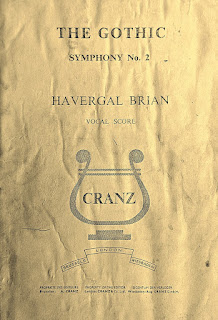The Gothic
by Havergal Brian
Symphony No.1 in D minor (originally No.2)
What is The Gothic?
The Gothic Symphony, composed by Havergal Brian between 1919 and 1927 is around 105 minutes long and is, according to the 1979 Guinness Book of World Records, among the longest and largest symphonies ever written.
The Stoke Gothic 1978
On 21st May 1978 members of the North Staffs Symphony Orchestra formed the core of the ad hoc 'Stoke Gothic Symphony Orchestra' in the full performance of the symphony which included over 800 performers. Conductor, Trevor Stokes. Producer, Paul Shaw. Our performance made it to the 1979 Guinness Book of Records!
Havergal Brian & The Gothic
William Havergal Brian was born in Dresden, Stoke-on-Trent. England in 1876 (d1972), a contemporary of Granville Bantock, Ralph Vaughan Williams and William Walton.
Brian worked on the symphony for eight years, mainly from his home near Brighton, and completed it in 1927. He submitted it to the Columbia Gramophone Competition in 1928, but it lost the top prize which went to Kurt Atterberg and his 6th Symphony.
A symphony in Two Parts
The Gothic Symphony is in two parts. The first is purely orchestral, while the second involves multiple choirs in a setting of the Latin hymn 'Te Deum.'
PART 1
The first movement is in extended sonata form, with a lively figure in D minor as the first theme, and a calm violin melody in D flat major as the second theme. Following the development section, there is no formal recapitulation, but rather a final coda.
The second movement is a solemn march, almost funerary in character.
The third movement is built up from a Brucknerian recurring ostinato, introduced by the horn section, and it leads up to a xylophone cadenza culminating in a march that brings the tonality back to the key of D minor.
Part I ends with a D major chord.
PART 2
Part II of the Gothic is notable for its use of Renaissance polyphony, polytonality, dissonance and medieval compositional techniques. The orchestra is expanded and the choirs and brass bands are brought in.
In the three movements of Part II, the text of the Te Deum is treated sometimes tenderly, sometimes raucously, sometimes homophonically, sometimes polyphonically and with many other creative approaches.
At the end, the choir closes the work softly in the key of E major with the words 'Non-confundar in aeternum' - let me never be confounded, confused or perplexed
Performers Required?
The Gothic Symphony lasts just under two hours and requires extravagant forcesStrings
20 first violins, 20 second violins, 16 violas, 14 cellos, 12 double basses, 2 harps
Woodwind
2 piccolos, 6 flutes, 1 alto flute, 6 oboes, 1 oboe d'amore, 1 bass oboe, 2 cors anglais, clarinet in E-flat, 5 clarinets in B-flat, 1 2nd E-flat clarinet, 2 basset horns, 2 bass clarinets in B-flat, contrabass clarinet in B-flat, 3 bassoons, 2 contrabassoons
Orchestral brass
8 horns in F, 8 trumpets, 2 cornets in E-flat, 1 bass trumpet, 3 tenor trombones, bass trombone, 1 2nd contrabass trombone, contrabass trombone, 2 euphoniums, 2 tubas
Percussion
2 sets of timpani, 2 bass drums, 3 snare drums, African long drum, 2 tambourines, 2 triangles, 6 pairs of large cymbals, gong, bird scare, thunder machine, (not thunder sheet) small chains, xylophone, glockenspiel, tubular bells, chimes in E-flat
Keyboards
celesta, organ
Voices
solo quartet - soprano, alto, tenor, and bass, 4 mixed choirs, children's choir
Four offstage brass bands
used in the fifth and sixth movements - comprising: 2 horns, 2 trumpets, 2 tenor trombones, 2 tubas, 1 set of timpani
The written word - all about The Gothic
Music and Meaning by Malcolm MacDonald 1978"Havergal Brian’s symphony The Gothic (1919-1927) is that strangest and most infrequently encountered kind of masterpiece: a work which sets out to be one thing but which turns, against its creator’s will, into something very different in the process of creation." more here>
Havergal Brian’s Gothic Symphony - Two studies
Harold Truscott, Paul Rapoport, Havergal Brian
with ‘How the Gothic Symphony came to be written’ by Havergal Brian more here>


%2002.jpg)
